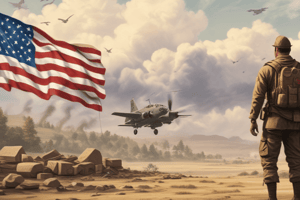Podcast
Questions and Answers
What did women do to imitate the seam of a nylon stocking during the war in 1944?
What did women do to imitate the seam of a nylon stocking during the war in 1944?
They drew lines on the backs of their legs.
What percentage of the population did the middle class grow to after the war?
What percentage of the population did the middle class grow to after the war?
- 50%
- 60% (correct)
- 40%
- 70%
The economy of the United States recovered immediately after the war.
The economy of the United States recovered immediately after the war.
False (B)
What legislative act was passed in 1944 to assist returning war veterans?
What legislative act was passed in 1944 to assist returning war veterans?
How many miles of federal highways were approved for funding in 1947?
How many miles of federal highways were approved for funding in 1947?
What amount of money did the Federal Highway Act provide for the construction of interstate expressways?
What amount of money did the Federal Highway Act provide for the construction of interstate expressways?
The Federal Highway Act helped create jobs in various sectors.
The Federal Highway Act helped create jobs in various sectors.
What was the significance of the GI Bill for veterans?
What was the significance of the GI Bill for veterans?
From 1946 to 1964, ___ million babies were born.
From 1946 to 1964, ___ million babies were born.
Flashcards are hidden until you start studying
Study Notes
Introduction to Post-War America
- In 1944, due to wartime shortages, women imitated nylon stocking seams on their legs.
- Post-World War II, from 1946 to 1960, marked a golden age for the U.S. with significant innovations and consumer goods.
- Unlike Europe, the U.S. was physically intact, leading to a construction boom that elevated living standards.
Economic Growth After the War
- Post-war U.S. experienced initial economic struggles during conversion to peacetime, involving three key issues:
- Demobilization of 12 million returning soldiers created a demand for jobs and housing.
- Rapid transition from wartime production (e.g., tanks) to consumer goods (e.g., cars) presented supply challenges.
- Inflation emerged as pent-up consumer spending confronted limited goods, driving prices up.
The GI Bill of 1944
- The Servicemen's Readjustment Act or GI Bill provided critical support for returning veterans, avoiding pitfalls experienced post-World War I.
- Key benefits included subsidies for job training, education, and low-interest home loans.
- Resulted in nearly 8 million veterans attending college and 5 million purchasing or building homes, significantly expanding the middle class.
Infrastructure Development and Economic Growth
- Congress initiated extensive highway construction, approving funds for 32,000 miles of federal highways in 1947 and $27 billion for 42,000 miles of interstate expressways in 1956.
- The Federal Highway Act stimulated economic growth, benefiting various sectors including construction and engineering, while creating jobs.
- By the end of the 1950s, the U.S. gross national product had doubled, highlighting rapid economic expansion linked to infrastructure investments.
Suburban Expansion and Consumer Culture
- The post-war era, particularly the Baby Boom from 1946 to 1964, saw 76 million births, significantly impacting demographics and housing trends.
- The rise of suburbia became a defining feature of American life, with increased consumerism and access to amenities, reflecting the prosperity of the middle class.
Studying That Suits You
Use AI to generate personalized quizzes and flashcards to suit your learning preferences.




